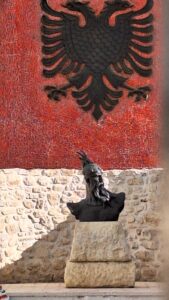Skanderbeg- The Unyielding Shield of Albania and Europe
6 May 1405 marks the birth of Gjergj Kastrioti Skanderbeg, one of the most revered figures in Albanian history and a legendary defender of Christian Europe. On this day, 620 years ago, a child was born in the mountains of northern Albania who would rise to defy empires, unite a fragmented people, and etch his name into the legacy of freedom, courage, and resistance.
The Rise of a Warrior
Born into the noble Kastrioti family, Gjergj was taken as a hostage by the Ottoman Empire and raised in their court, converted to Islam, and trained as a commander in their army. But he never abandoned his true identity. In 1443, in a stunning act of rebellion, he deserted the Ottomans, reclaimed his ancestral fortress in Krujë, and raised the Albanian double-headed eagle flag, declaring a war of liberation.
From that moment until he died in 1468, Skanderbeg became a relentless opponent of Ottoman domination, uniting the Albanian principalities under his command and organizing a long and heroic resistance.

A Fortress of Christian Europe
Skanderbeg was not only fighting for Albania—he was defending Christian Europe. His defiance held back the Ottoman tide at a time when much of the Balkans had already fallen. His victories became symbols of hope in the West.
The Battle of Torvioll (1444), where Skanderbeg defeated a vastly superior Ottoman army, and the three legendary sieges of Krujë, where his fortress stood unbroken against the sultans’ forces, remain some of the most celebrated military episodes in medieval Europe.
The Vatican and many European leaders regarded him as a crucial bastion of defense. Pope Callixtus III named him “Athleta Christi” (Champion of Christ), while Western powers sent funds, troops, and honors to recognize his role as a bulwark against Islamic expansion into Europe.
Legacy Beyond Death
Skanderbeg died in 1468, yet his legend only grew. The Ottomans, despite finally occupying Albania, feared his memory so much that they exhumed his remains and made talismans from his bones, believing they carried supernatural power.
Over centuries, Skanderbeg’s image inspired freedom fighters, from the Albanian national awakening in the 19th century to anti-fascist resistance in the 20th. His helmet, adorned with a goat’s head, and his 7 kg sword remain national symbols, and they were preserved in Vienna and admired by generations.

Myths and Cultural Impact
Skanderbeg is the subject of countless legends:
That his sword could split boulders, and he never lost a duel.
His horse sensed danger and carried him through battle untouched.
The sound of his name made enemies flee.
Poets, writers, and historians, from Marin Barleti to Voltaire and Edward Gibbon, wrote of his brilliance and determination. Barleti called him the “Alexander of Epirus,” symbolically linking him with Alexander the Great.
A Timeless Symbol of Unity and Resistance
Today, on his 620th birthday, Skanderbeg remains more than a historical figure—he is the soul of a nation and a timeless example of leadership, unity, and courage in the face of overwhelming odds. For Albanians worldwide, his legacy is a call to preserve culture, stand against division, and protect freedom.
In a world still facing rising tensions and attempts to rewrite history, Skanderbeg’s story reminds us of the power of resistance, the strength of identity, and the importance of standing for what is just.
—
Happy 620th birthday, Skanderbeg. The flame you lit still burns in every Albanian heart.


Other News to Read
Tirana Photo Festival 2025- Mediterranean
The Tirana Photo Festival 2025 took place from June 18 to 30, 2025, in Tirana, with the theme…
What to do in July in Tirana
Welcome July! It’s time to dive into the essence of summer: Tirana is the best destination for this…
Sofra e Tiranes – the capital’s traditional festival
For 31 years, Sofra e Tiranes has been a highly anticipated event in the Tirana community.
International Tirana Photo Festival 2025 –Mediterranean
International Tirana Photo Festival 2025 –Mediterranean, 8th edition, from 18 to 30 June 2025